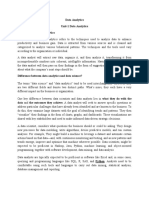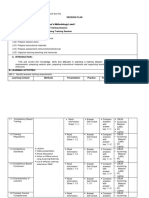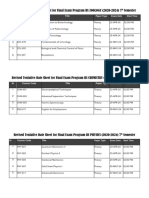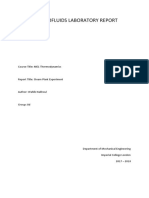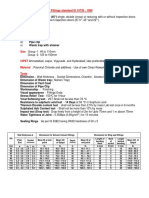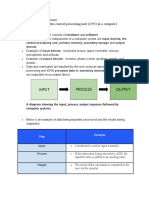Career Essentials in Data
Analysis
Building a strong foundation in data analysis opens doors to one of today's most in-demand career paths. This presentation explores
the key skills, tools, and strategies needed to succeed in this dynamic field.
�Understanding the Data Analysis Landscape
Today's organizations rely on data-driven insights to make critical business decisions. Let's explore the key roles and responsibilities in this
evolving field.
1 2 3
Data Analyst Business Intelligence Data Scientist
Analyst
Transforms raw data into actionable Focuses on using data to inform Applies advanced statistics, machine
insights through collection, business strategy and operations learning, and programming to extract
organization, and analysis deeper insights
Specializes in translating complex
Works with SQL, Excel, and findings for non-technical audiences Builds predictive models and
visualization tools Works closely with management and algorithms
Creates reports and dashboards for operations teams Often requires advanced degrees or
stakeholders Requires strong business acumen specialized training
Typically requires bachelor's degree alongside technical skills Career progression path for many
in analytics, statistics, or related field analysts
�Essential Technical
Skills
Mastering these core tools and technologies creates the foundation for success in data analysis roles.
SQL Python
The universal language for working with databases. Master joins, Libraries like pandas, NumPy, and scikit-learn enable sophisticated data
aggregations, and subqueries to extract precisely the data you need. manipulation and advanced statistical analysis.
Excel Visualization Tools
Beyond basics: VLOOKUP, pivot tables, Power Query, and statistical Tableau, Power BI, or Python's matplotlib/seaborn create compelling
functions transform Excel into a powerful analytical tool. visuals that communicate insights effectively.
According to LinkedIn's 2023 Jobs Report, proficiency in SQL remains the most requested skill in data analyst job postings, appearing in over 85% of listings.
�Data Collection and
Cleaning
The critical first steps that determine the quality of your analysis. As the saying
goes: "Garbage in, garbage out."
Identify Quality Data
Sources
Evaluate data for relevance, accuracy, completeness, and timeliness before
investing analytical effort.
Master Data Cleaning
Techniques
Handle missing values appropriately (imputation vs. removal)
Identify and address outliers
Standardize formats and units
Remove duplicates and inconsistencies
Document Your
Process
Create reproducible workflows that allow others to understand and verify
your methods.
�Statistical Analysis
Fundamentals
Statistics transforms raw data into meaningful insights, helping you identify patterns, test hypotheses, and make predictions.
Descriptive Statistics
Measures of central tendency (mean, median, mode)
Measures of dispersion (range, variance, standard deviation)
Distribution shapes and properties
Inferential Statistics
Hypothesis testing
Confidence intervals
Statistical significance
�Storytelling with Data
The most brilliant analysis is worthless if you can't communicate its meaning effectively to
stakeholders.
Start with the
Question
Frame your analysis around a clear business question that resonates with
your audience's needs and priorities.
Focus on Key
Insights
Distill complex findings into 2-3 main takeaways. Resist the urge to show all
your work.
Recommend Actions
Always connect insights to specific, actionable recommendations that
deliver business value.
"The goal is not to create the most comprehensive analysis, but to drive better
decisions through clear, compelling data narratives."
�Portfolio
Development
A strong portfolio demonstrates your skills to potential employers far more effectively than a resume alone.
Personal Projects GitHub Repository Data Blog or
Website
Choose interesting datasets from Kaggle, data.gov, or other public sources Showcase clean, well-commented code Explain your thought process and methodology
Document your entire process from question to conclusion Include README files explaining project context and findings Highlight your communication and visualization skills
Demonstrate a range of technical and analytical skills Demonstrate version control best practices Build your personal brand in the data community
Pro tip: Focus on quality over quantity. Three well-executed, thoroughly documented projects are more impressive than dozens of superficial analyses.
�Industry-Specific Applications
Data analysis skills are valuable across virtually every industry, but applications and techniques vary significantly by sector.
Financial Services
Healthcare Risk assessment
Patient outcome analysis Fraud detection
Population health management Customer segmentation
Operational efficiency
Retail
Inventory optimization
Customer journey analysis
Pricing strategy
Manufacturing
Quality control Technology
Supply chain optimization Product analytics
Predictive maintenance User behavior modeling
A/B testing
Understanding domain-specific challenges and terminology significantly increases your value as an analyst in specialized industries.
�Continuous Learning
The field of data analysis evolves rapidly. Staying current requires ongoing education and community engagement.
Online Learning Community
Resources Engagement
Coursera, edX, and DataCamp for structured courses Join Kaggle competitions to practice real-world problems
YouTube channels like StatQuest and Data Professor Attend local meetups and data conferences
Books: "Storytelling with Data" and "Python for Data Analysis" Participate in forums like Reddit's r/datascience
Follow thought leaders on LinkedIn and Twitter
"The most successful data analysts combine technical skills with curiosity, critical thinking, and a commitment to lifelong learning."
Remember: Every analysis project is an opportunity to learn something new. Approach each challenge with curiosity and a growth mindset.













